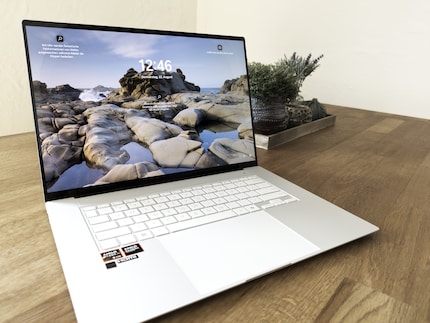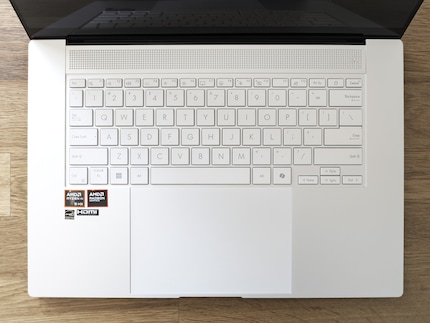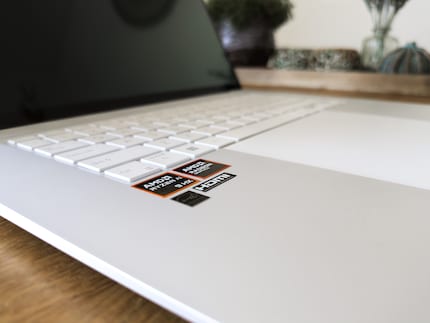
Background information
Snapdragon X Elite review – how well do the Microsoft Surface Pro and Laptop perform?
by Martin Jud

With the new Ryzen AI 300 chips, AMD is not only improving performance, but also energy efficiency in particular. The Asus Zenbook S 16 tested here achieves runtimes that were recently unthinkable with x86 architecture.
After Qualcomm launched a frontal attack on the laptop world in June with its Arm-based Snapdragon X chips, AMD and Intel are under pressure to deliver. In the meantime, however, only Intel has to deliver, because AMD is doing this properly with the new AMD Ryzen AI 300 aka Strix Point: in the test of the Asus Zenbook S 16, the Ryzen AI 9 HX 370 system-on-a-chip (SoC) demonstrates an energy efficiency that was previously unthinkable with the x86 architecture.
The battery life of new AMD laptops is thus entering dimensions that were previously reserved for MacBooks and Windows arm notebooks. But the CPU performance also has nothing to hide, although it doesn't quite match the Arm competition.
But AMD has the most powerful NPU to date - an AI unit with a nominal performance of 50 or 55 Tera Operations per Second (TOPS), depending on the model. For comparison: Qualcomm's Snapdragon X chips have 45 TOPS. Ryzen also has a better GPU, which enables smooth gaming in "Red Dead Redemption 2" at 1080p and medium settings.
Notebooks with AMD Ryzen AI 300 are among the first mobile devices that are also referred to as Copilot+ PC (and whose keyboard has a Copilot key) due to their powerful NPU. This allows them to benefit from additional AI functions. In this article, however, I will focus on the CPU, GPU, gaming performance and battery life
The Ryzen AI 300 is currently available in three variants. The second-best version, the Ryzen AI 9 HX 370, is installed in the test device. The only difference between the two better chips is a ten per cent higher NPU performance:
The TDP can be configured by the manufacturer. It is 28 watts by default. On this Asus Zenbook S 16 test device, I measured up to 32 watts during benchmarks and gaming. With a power consumption of 17 watts, the AMD SoCs should perform best in terms of "energy efficiency versus performance". This is one of the reasons why the predecessor chips are often installed in handhelds (for example in the Asus ROG Ally).
This is probably also the reason why the TDP of the Zenbook S 16 was set to 17 watts in the "Balanced" energy-saving plan (active on delivery) by the manufacturer. Incidentally, I measure a minimum of 4 watts in idle mode under Windows 11, regardless of the energy-saving plan.

Aside from the SoC, the Zenbook has up to 32 gigabytes of LPDDR5X memory, up to one terabyte of SSD storage and a 78 watt-hour battery. It is relatively large, but the device still only weighs 1.5 kilograms and is just 1.29 centimetres thick.
Its 16-inch OLED display has a resolution of 2880 × 1800 pixels (16:10 format). It offers a refresh rate of up to 120 hertz, a brightness of 400 nits (HDR peak is 500 nits), is Pantone validated and is said to cover the DPI-P3 colour space to 100 per cent.
In terms of connections, there is one USB 3.2 Gen 2 Type A, two USB 4.0 Gen 3 Type-C, HDMI 2.1, a 3.5 mm jack and an SD card reader. Wi-Fi 7 and Bluetooth 5.4 provide further connectivity.

The keyboard is relatively quiet and its keys have a clear pressure point and a travel of 1.1 millimetres. Speakers, microphone and full HD camera with IR function for Windows Hello face recognition are also included. Asus delivers the device with Windows 11 Home.
Optically, I like the test device, whose colour Asus calls Scandinavian White. However, there is only a grey version available in our shop at the time of writing. The casing surface is made of an aluminium-ceramic mix and feels pleasant to the touch.
To test the processor performance of the new AMD Ryzen AI 9 HX 370, I use Geekbench 6 and Cinebench 2024. The Apple MacBook Pro, which is based on Arm architecture and also offers twelve cores with the M3 Pro, serves as a comparison device. A comparison with the M3 MacBook Air also makes sense, as it is closer in price to the test device. I also compare the Zenbook with the powerful Arm-based Snapdragon X Elite (X1E-84-100) of the new Microsoft Surface Pro (Copilot+ PC, 11th edition).
In the Intel x86 competition, the Surface Laptop Studio 2 as the most powerful Microsoft device ever - in addition to a 13th Gen Intel CPU, it also has a dedicated graphics card (Nvidia GeForce RTX 4060 Laptop). And then there are two current laptops with Intel Core Ultra.
As I am only listing devices tested by our editorial team, a current, more powerful AMD notebook is missing from the comparison. Instead, I have included a SoC from AMD's previous generation that is often used as a gaming handheld chip: The AMD Ryzen 7 8840U (GPD Win Mini 2024) is the same SoC that is also in the Asus ROG Ally (AMD Ryzen Z1 Extreme), but with an additional, rather slow, AI chip. The AMD SoC offers high performance, especially with low watt consumption (15-20 watts). However, I ran it at 28 watts for this comparison (only possible after a manual BIOS update). All other devices are running at the TDP configured by the manufacturer:
In Geekbench 6's single-core performance, the new AMD chip comes fourth in the test field. The gap to the two MacBooks is around twelve per cent. Around two per cent to Microsoft's convertible with Snapdragon X Elite. In the multi-core category, AMD manages third place thanks to more cores compared to the MacBook Air - here the gap to Apple's M3 Pro is also around twelve per cent, compared to the Surface Pro it is around six per cent.
The picture is slightly different with Cinebench:
In the Cinebench 2024 single-core test, the new AMD CPU performs exactly the same as the 13th Gen Intel CPU in Microsoft's Surface Laptop Studio 2 (111 points). The two MacBooks are once again enthroned at the top - this time with a 21 per cent higher performance. In third place ahead of the AMD CPU is the one from Qualcomm with a good ten per cent more power.
The situation is different with multi-core: here, the AMD CPU achieves an eight per cent increase in performance compared to Qualcomm. Only the MacBook Pro keeps AMD at bay with a good nine per cent more performance.
To test the graphics performance, I rely on GPU benchmarks that are available for both x86 and Arm Windows as well as macOS. These are the Geekbench 6 graphics test on the one hand and 3DMark Wild Life Extreme Unlimited on the other.
The blue results in the following Geekbench chart were obtained using the OpenCL or Metal API (for MacBooks). The green ones with the Vulkan API:
It's no surprise that the Microsoft Surface Laptop Studio 2 comes out on top in the graphics tests. After all, it is the only laptop with a dedicated graphics card, the Nvidia GeForce RTX 4060. It is remarkable how close Apple comes with its MacBooks and their integrated GPUs. The gap to the iGPU of the Apple M3 Pro is only 16 per cent. Otherwise, the AMD Radeon 890M, which is part of the new Ryzen, leads the rest of the field with 39,969 points using the Vulkan API. Using the OpenCL API, it is less keen to get up to speed. It is quite possible that even more is possible with future drivers.
It is striking how poorly the iGPU of the Snapdragon performs. The large gap to the AMD pre-generation in the GPD Win Mini 2024 (AMD Radeon 780M) is partly due to the fact that the iGPU only has 12 compute units, while the newer Radeon has 16, resulting in a performance increase of 28 per cent in the score.
The results of the second benchmark largely confirm those of the first:
Unfortunately, I am missing a result from the Huawei MateBook X Pro in this benchmark. However, this has the same iGPU as the HP Spectre x360.However, in 3DMark Wild Life Extreme Unlimited, the Intel Arc iGPU and the pre-generation Ryzen iGPU do not perform as well, putting the Snapdragon chip in third-last place. The new AMD SoC offers the best iGPU performance of all Windows laptops in the test field
The test field is smaller when it comes to gaming. The Apple devices are omitted because they cannot do anything with the DirectX-based 3DMark test and the game "Red Dead Redemption 2". The Huawei MateBook X Pro is also no longer included - instead, the HP Spectre X360 shows what is possible with a current Intel CPU-iGPU combination.
I use 3DMark Fire Strike to test how well the devices perform when gaming in 1080p resolution. The test runs with DirectX 11 and is actually intended for gaming PCs. Here are the results:
With the latest dedicated graphics card and a powerful Intel Core i7 that lags two generations behind, the Microsoft Surface Laptop Studio 2 easily manages to leave the iGPU competition behind. It also has the smallest difference between the green GPU score bar and the yellow CPU score bar. With its Fire Strike score of 20,133, it offers around 60 per cent more performance than the Asus Zenbook S 16 with AMD Ryzen AI 9 HX 370.
AMD's latest offering took second place with 8437 points ahead of the almost nine per cent weaker Intel Core Ultra 7 155H in the HP Spectre x360. Let's see if Intel can catch up again when new mobile SoCs follow in autumn.
The performance increase compared to the AMD pre-generation in the GPD Win Mini 2024 is 33 per cent. Qualcomm's Snapdragon X Elite in the Surface Pro brings up the rear.
But what do these points mean in terms of frames per second (FPS)? To find out, I run the benchmark of "Red Dead Redemption 2". For the resolution of all devices, I choose the one that matches the 3:2 and 16:10 displays, which is closest to 1080p: 1920 × 1200 pixels (WUXGA). I only set the GPD handheld with 16:9 format to 1920 × 1080 pixels. The graphics settings are all set to "Medium", ray tracing is deactivated - a number of super-resolution functions are also inactive:
The Surface Laptop Studio 2 achieves an average of three times as many frames per second (138 FPS) as the Asus Zenbook S 16 with the latest AMD SoC. What's special is that I can play "Red Dead Redemption 2" smoothly for the first time ever with AMD at medium graphics settings and WUXGA resolution (close to 1080p). The FPS never drops below 34.
With the iGPU competition, on the other hand, it does this with every device, although the Surface Pro and its Snapdragon X Elite have another problem: With them, the FPS in battles regularly drops to 2. Since such large FPS drops don't occur with other games (such as "Cyberpunk 2077"), I suspect that a driver update could fix this problem with the Snapdragon.
Whatever the case, for AMD the result means that the new SoC is even better suited for handheld gaming than its predecessor. With the GPD handheld, the game is only halfway playable due to a minimum FPS that is a third weaker - and with the HP Spectre and the Intel Core Ultra SoC as well.
For reviews that are not focused on the processor, but on the entire notebook, I will only show the "Gaming" and "Modern Office" battery life tests from PCMark 10 here. However, I would also like to draw a comparison with the Snapdragon X Elite and Apple M3 (Pro). Unfortunately, the PCMark tests are not yet available for Arm-based CPUs. That's why there's now a battery life test according to my own rules.
I switch to an old test methodology - video streaming. As a result, the non-arm-based comparison devices in the test field differ from the upper benchmarks. Unfortunately, I am missing results from AMD's and Intel's previous generation in this test. Instead, three devices with the twelfth Intel generation from the beginning of 2022 are listed. I have also included the two latest Surface laptops, which have the same Snapdragon X Elite as the Surface Pro (but different display and battery sizes).
Before the video streaming test begins, I measure the brightness of the displays and set them to 400 nits. Then I start streaming 1080p videos (SDR) until the device has dropped from 100 per cent battery level to 3 and shuts itself down:
The Asus Zenbook S achieves a runtime of ten hours and 48 minutes when streaming video with the new AMD chip. This is an excellent value, which is the first time that a powerful x86 processor has landed in the realms that were previously firmly in arm's reach. Depending on the display size and battery capacity, the Snapdragon Surface devices and MacBooks perform slightly worse or better than AMD. The crown in this discipline belongs to the Microsoft Surface Pro with almost twelve hours - only closely followed by the Apple MacBook Pro with eleven hours and 40 minutes.
With PCMark 10 Professional Edition, the battery performance can be tested using various scenarios standardised. I test the battery life with the "Modern Office" and "Gaming" profiles. The Office test aims to achieve a "realistic task balance of writing, web browsing and video conferencing, separated by short idle times". The gaming test "puts the system under a constantly high load" by running the Fire Strike Gaming Benchmark in a continuous loop. It determines the lower limit of the runtime with one battery charge:
The Asus Zenbook S 16 offers eleven hours and 51 minutes of "office work" on a single charge. When gaming, the notebook achieves one hour and 36 minutes. By comparison, the Microsoft Surface Laptop Studio 2 achieves nine hours and 24 minutes of "office work" and one hour and ten minutes of gaming in the same tests.
To be fair, I have to say that I had an x86 notebook at the start of PC Mark 10 "Modern Office" that achieved a similarly long runtime: With the Asus Zenbook S 13 OLED, which has an Intel Core i7-1355U, a 63-Wh battery and a 13.3-inch display, it was eleven hours and 30 minutes.
As long as Windows isn't downloading countless updates after the first boot, the fan can't be heard when working in the office or surfing the web. If I utilise the CPU and iGPU, the fan is clearly audible, albeit moderately compared to a notebook with a dedicated graphics card:
For comparison: The Surface Laptop Studio 2 reaches up to 49.6 and 47.5 decibels. The Surface Pro with Snapdragon X Elite reaches 45.5 and 39.9 decibels

The Ryzen AI 9 HX 370 impresses with its overall performance in the Asus Zenbook S 16. In detail, the new AMD SoC offers CPU performance that rivals that of the new Qualcomm Snapdragon X Elite and is right up there with it - at least as far as mobile devices for Windows and Linux are concerned. However, AMD's CPU performance is around twelve per cent weaker than that of the MacBook Pro, which takes the mobile CPU victory with the M3 Pro.
A similar picture emerges for graphics performance, but without Snapdragons in the front field - they have a poor iGPU, which finishes in last place. Only dedicated graphics cards and the chips from Apple can beat the new AMD SoC, or rather its Radeon 890M. This is good news for future handhelds with AMD chips. Compared to the in-house predecessor chips already popular with various consoles, performance has increased by around 28 per cent.
In terms of gaming performance, the increase in graphics performance is reflected in the fact that "Red Dead Redemption 2", for example, can be played smoothly for the first time with an iGPU at 1080p resolution and medium graphics settings - in other words, without the frame rate ever dropping below 30 frames per second.
It is also great that the battery lasts just as long as that of the Arm competition. With this test device, I can stream videos for almost eleven hours at maximum display brightness. Or use it for twelve hours for office work before the battery runs out.
I can absolutely recommend the new mobile AMD Ryzen AI 300. Due to the better graphics performance, I would be more likely to use one of these than a Qualcomm Snapdragon X Elite. And even sooner than a current Intel SoC. Let's see if that changes when Intel gets its latest buns out of the oven in autumn.
Pro
Contra
I find my muse in everything. When I don’t, I draw inspiration from daydreaming. After all, if you dream, you don’t sleep through life.